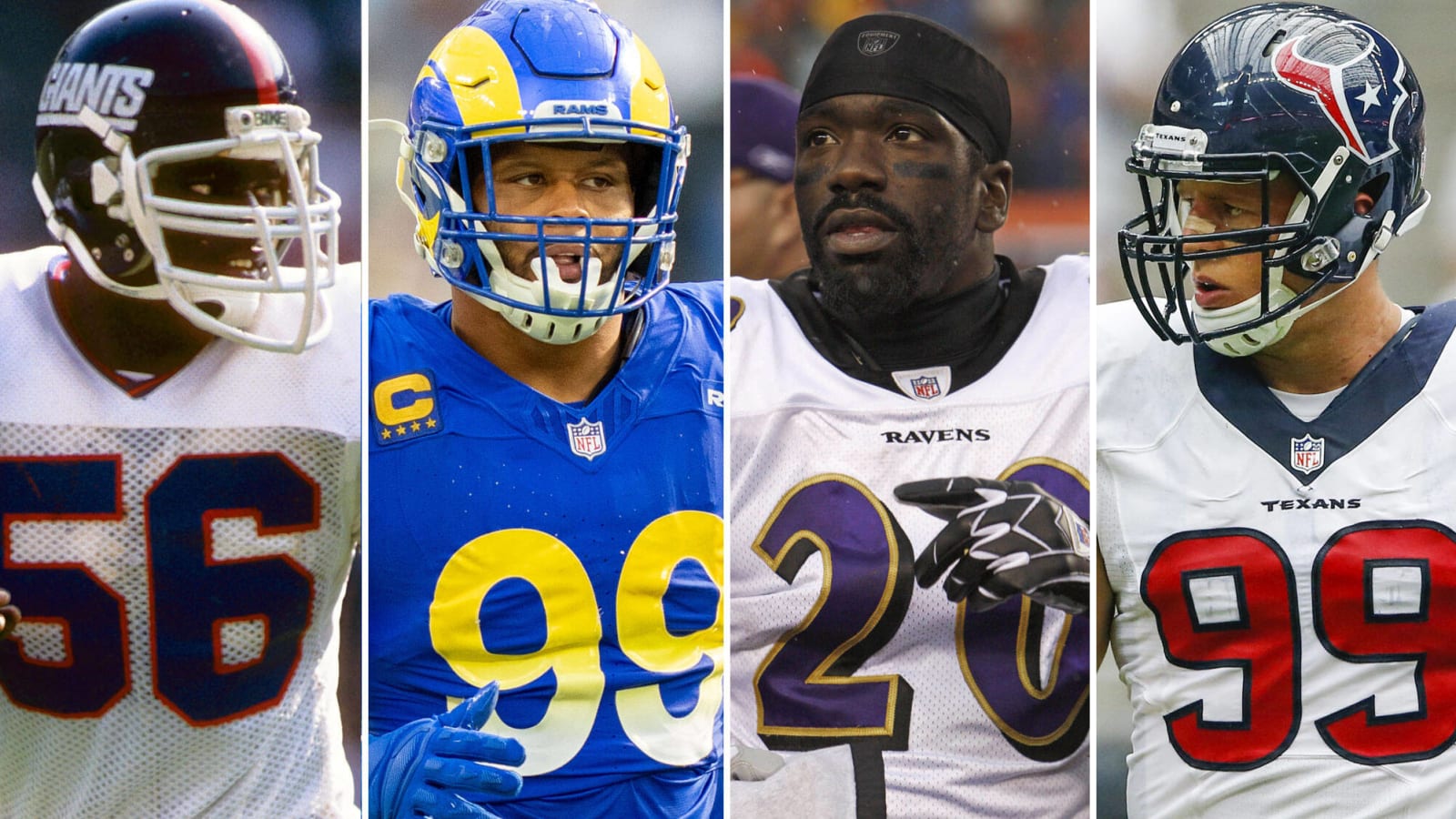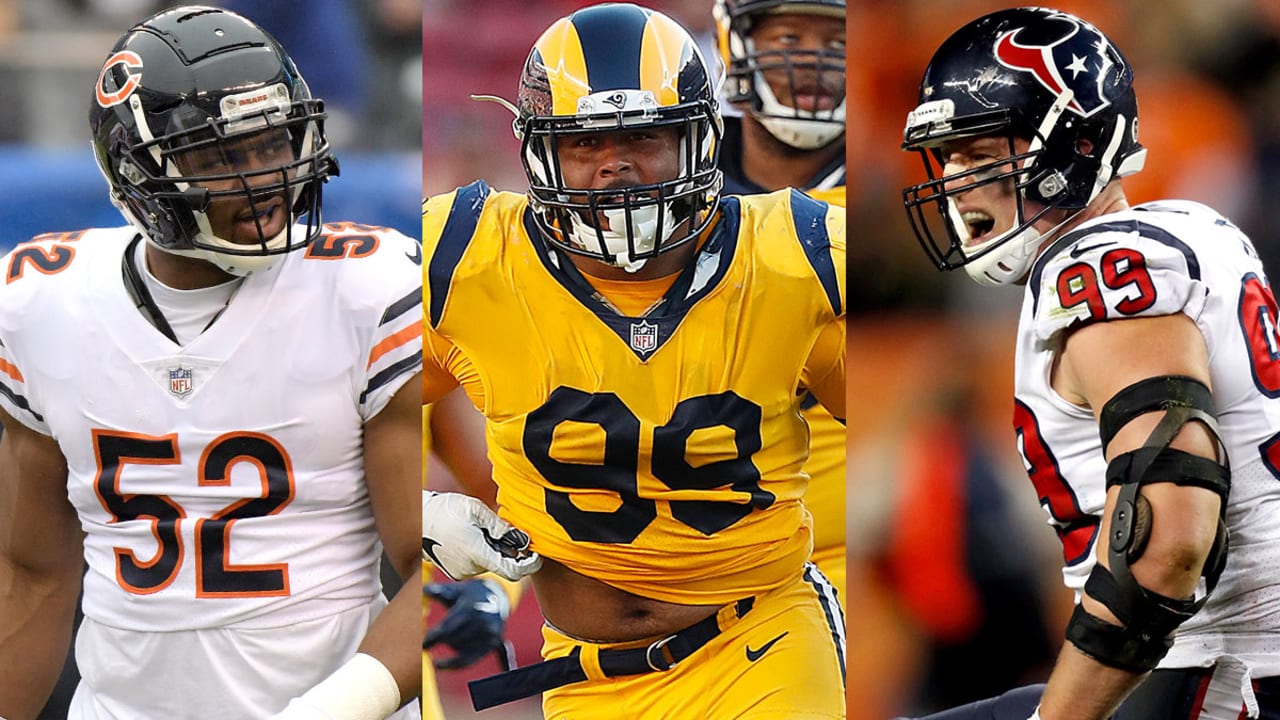The NFL Defensive Player of the Year Award

The NFL Defensive Player of the Year award is one of the most prestigious honors in professional football, celebrating the league’s most outstanding defensive player each season. Established by the Associated Press (AP) in 1971, this accolade recognizes players who have exhibited exceptional skill, performance, and impact on the defensive side of the game. The award highlights the importance of defense in football and honors the individuals who set the standard for excellence in defensive play.
Importance and Prestige of the Award

Winning the NFL Defensive Player of the Year award is a significant milestone in any player’s career. It not only acknowledges individual talent and hard work but also cements a player’s legacy in the annals of NFL history. Past winners include legendary figures like Lawrence Taylor, Reggie White, and J.J. Watt, who have not only excelled on the field but have also become iconic figures in the sport. The award is highly respected by players, coaches, and fans alike, and it often serves as a benchmark for Hall of Fame consideration.
Criteria for Selection
The selection process for the NFL Defensive Player of the Year is rigorous and comprehensive. The award is decided by a panel of 50 sportswriters and broadcasters who cover the NFL on a regular basis. These experts evaluate players based on a variety of factors, including statistical performance, impact on games, consistency throughout the season, and the ability to make game-changing plays. Players who demonstrate leadership, resilience, and an extraordinary level of play are often the top candidates for this coveted honor. For more information on the NFL Defensive Player of the Year award, you can visit the official NFL website or check out the detailed history and past winners on Wikipedia.
Historical Background
Origins of the Award
The NFL Defensive Player of the Year award was first introduced in 1971 by the Associated Press (AP) to recognize the most outstanding defensive player in the league. The creation of this award underscored the growing appreciation for defensive talent and contributions in a sport often dominated by offensive highlights. The inaugural award went to Alan Page, a defensive tackle for the Minnesota Vikings, who set a high standard for future recipients with his dominant performance on the field.
Evolution of the Award Over the Years
Since its inception, the NFL Defensive Player of the Year award has evolved to reflect the changing dynamics of the game. Initially, the award was dominated by linemen and linebackers, who were the focal points of traditional defensive schemes. However, as the game evolved, incorporating more complex passing offenses and versatile defensive strategies, the range of positions recognized has expanded. This evolution mirrors the broader strategic shifts within the NFL, where the role of defensive backs, hybrid linebackers, and edge rushers has become increasingly significant.
Key Milestones and Changes in Selection Criteria
- 1971: Alan Page becomes the first recipient, setting a precedent for excellence in defensive play.
- 1981 and 1982: Lawrence Taylor wins consecutive awards, highlighting the impact of dominant pass rushers.
- 1990: Bruce Smith’s recognition underscores the importance of defensive consistency and longevity.
- 2004: Ray Lewis becomes the first player to win the award multiple times, demonstrating the significance of leadership and playmaking ability.
- 2014: J.J. Watt wins his third award, exemplifying the modern era’s focus on versatile defensive linemen who can disrupt both the pass and run game.
Over the years, the selection criteria have also adapted. While individual statistics such as sacks, interceptions, and tackles remain crucial, the overall impact on a team’s defensive success and the ability to perform in high-pressure situations have gained importance. Additionally, intangibles like leadership, resilience, and the ability to elevate the performance of teammates are increasingly considered by voters. For a comprehensive list of past winners and detailed information about the evolution of the award, you can explore the Pro Football Hall of Fame.
Notable Winners
Early Years
Overview of the First Recipients
The NFL Defensive Player of the Year award’s early recipients set the foundation for the defensive excellence that the award celebrates. The inaugural winner, Alan Page of the Minnesota Vikings, earned the honor in 1971 for his exceptional performance as a defensive tackle. Page’s ability to disrupt offensive lines and pressure quarterbacks made him a standout player. Following Page, other notable winners in the early years included Joe Greene, known for his dominance on the Pittsburgh Steelers’ “Steel Curtain” defense, and Jack Lambert, whose ferocity and leadership defined the linebacker position.
Notable Defensive Strategies and Plays
The early years of the award saw defenses that were built around a strong front seven, with linemen and linebackers playing crucial roles. The “Steel Curtain” defense of the 1970s Pittsburgh Steelers, anchored by players like Joe Greene and Jack Lambert, is a prime example. This defense focused on overwhelming offensive lines, stopping the run, and pressuring the quarterback. Signature plays included fierce tackles, timely interceptions, and game-changing sacks, which became hallmarks of the award’s early recipients.
Modern Era

Recent Winners and Their Impact on the Game
In the modern era, the NFL Defensive Player of the Year award has recognized a diverse group of players who have excelled across various defensive positions. Recent winners include cornerbacks, safeties, and defensive linemen, reflecting the evolving nature of NFL defenses. Notable recent winners include Aaron Donald, a defensive tackle for the Los Angeles Rams, who has redefined the position with his unprecedented combination of strength, speed, and technique. Khalil Mack, a linebacker and defensive end, has also been celebrated for his versatility and ability to dominate both the pass rush and run defense.
Highlighting Dominant Performances and Statistics
Modern-era winners have showcased dominant performances and impressive statistics. Aaron Donald, for instance, has consistently ranked among the league leaders in sacks, tackles for loss, and quarterback pressures. His 2018 season, where he recorded 20.5 sacks, stands out as one of the most dominant performances by a defensive tackle in NFL history. Similarly, Stephon Gilmore, the 2019 winner, excelled as a lockdown cornerback for the New England Patriots, leading the league in interceptions and pass deflections, and consistently shutting down top wide receivers. The impact of these players extends beyond individual statistics. Their presence on the field transforms defenses, elevating the play of teammates and often shifting the strategic focus of opposing offenses. For more detailed statistics and highlights of recent winners, you can visit the NFL’s official player stats page or check out the Pro Football Reference for historical data.
Legendary Performances
Record-Breaking Seasons
Several NFL Defensive Players of the Year have set remarkable records during their award-winning seasons, leaving an indelible mark on the league’s history. Lawrence Taylor, who won the award in 1981, recorded 20.5 sacks in a single season, setting a new standard for linebackers. His relentless pursuit of quarterbacks and ability to disrupt offensive plays made him a nightmare for opposing teams. In 1986, Taylor once again made history by becoming the first and only defensive player to win the NFL MVP award, showcasing his unparalleled dominance on the field.
Another record-setting season came in 2001 when Michael Strahan of the New York Giants set the single-season sack record with 22.5 sacks. Strahan’s performance was characterized by his incredible ability to overpower offensive linemen and relentlessly pressure quarterbacks, solidifying his status as one of the greatest defensive ends of all time. More recently, Aaron Donald has repeatedly etched his name in the record books. In 2018, Donald recorded 20.5 sacks, the most ever by a defensive tackle, earning him his second Defensive Player of the Year award. His combination of speed, strength, and technique has revolutionized the defensive tackle position, making him a perennial candidate for the award.
Game-Changing Moments
Iconic plays often define the seasons of NFL Defensive Players of the Year, showcasing their ability to change the course of games single-handedly. In 1985, Chicago Bears linebacker Mike Singletary had numerous game-changing plays, but one of the most memorable was his performance against the San Francisco 49ers, where his leadership and defensive acumen helped the Bears secure a dominant victory. Singletary’s intense focus and relentless pursuit of the ball carrier became emblematic of the Bears’ feared “Monsters of the Midway” defense.
In 2002, Tampa Bay Buccaneers’ Derrick Brooks made a season-defining play during Super Bowl XXXVII. Brooks intercepted a pass and returned it for a touchdown, sealing the Buccaneers’ victory and capping off a season where his defensive prowess was instrumental in leading Tampa Bay to its first Super Bowl title. J.J. Watt’s 2014 season was filled with memorable moments, but his pick-six against the Buffalo Bills stands out. Watt intercepted a pass and returned it 80 yards for a touchdown, showcasing his versatility and athleticism. This play was a testament to Watt’s ability to impact the game in multiple ways, whether through sacks, tackles for loss, or scoring touchdowns himself.
These record-breaking seasons and game-changing moments highlight the extraordinary talent and impact of NFL Defensive Players of the Year. For more in-depth analysis of these legendary performances, you can visit NFL’s Top 100 Plays or explore Pro Football Hall of Fame Highlights.
Defensive Trends
Analysis of Defensive Trends and Strategies Over the Decades
The evolution of defensive strategies in the NFL has significantly influenced the selection of the Defensive Player of the Year award, highlighting shifts in how defenses adapt to the changing dynamics of the game. Over the decades, the NFL has seen a variety of defensive trends, each characterized by different tactics and player roles that have shaped the criteria for selecting the league’s top defensive player.
1970s: The Rise of the Steel Curtain
In the 1970s, the “Steel Curtain” defense of the Pittsburgh Steelers set a standard for defensive excellence. Anchored by legendary players like Joe Greene and Jack Lambert, this era focused on a dominant front seven that could overpower offensive lines and stop the run effectively. Defensive schemes relied heavily on physicality and brute force, with a strong emphasis on linebackers and defensive linemen. This period saw many Pro Bowl selections from these positions, as their impact on the game was undeniable.
1980s: The Advent of Aggressive Pass Rushers
The 1980s brought a shift towards aggressive pass-rushing techniques, epitomized by players like Lawrence Taylor of the New York Giants. Taylor’s ability to rush the passer and disrupt offensive plays revolutionized the linebacker position. The selection of Defensive Players of the Year during this decade often favored those who excelled in sacking quarterbacks and creating turnovers. This trend highlighted the increasing importance of disrupting the opponent’s passing game, a strategy that has remained crucial in modern football.
1990s: Versatility and Coverage Skills
The 1990s introduced more versatile defensive players who could excel in both pass coverage and run defense. Players like Rod Woodson and Deion Sanders exemplified this trend with their exceptional skills as cornerbacks who could shut down top receivers and make significant plays on the ball. The rise of these versatile defenders influenced the selection of winners, as the ability to adapt to various offensive schemes became a prized trait. The Pro Bowl rosters during this period reflected this versatility, with a more diverse representation of defensive backs and hybrid players.
2000s: The Era of Dominant Defensive Linemen
The 2000s saw the emergence of dominant defensive linemen who could single-handedly change the course of games. Players like Michael Strahan, Warren Sapp, and later, Aaron Donald, demonstrated the importance of interior defensive line play. Their ability to generate pressure up the middle and disrupt both the run and pass made them standout candidates for the AP Defensive Player of the Year. This era emphasized the value of a strong defensive line in controlling the line of scrimmage and forcing offenses into difficult situations.
2010s to Present: Hybrid Defenders and Advanced Metrics

In recent years, the NFL has seen a rise in hybrid defenders who can play multiple positions and adapt to various roles on the field. Players like Khalil Mack and J.J. Watt exemplify this trend with their ability to play both linebacker and defensive end, making them versatile weapons in defensive schemes. Additionally, the use of advanced metrics and analytics has influenced the selection process, providing deeper insights into a player’s impact beyond traditional statistics. The NFL Honors and AP Defensive Player of the Year awards now consider a broader range of data to identify the most impactful defenders.
How These Trends Influenced the Selection of Winners
The changing defensive trends over the decades have directly influenced the criteria for selecting the NFL Defensive Player of the Year. As the game evolved, so did the attributes that defined an elite defender. In the 1970s, brute strength and the ability to stop the run were paramount, while the 1980s shifted the focus to pass-rushing prowess. The 1990s and 2000s emphasized versatility and interior dominance, respectively, and the modern era values hybrid abilities and advanced statistical analysis. These evolving criteria reflect the dynamic nature of football, where defenses must constantly adapt to new offensive strategies. The NFL Honors and Pro Bowl selections mirror these trends, showcasing the league’s best defenders who excel in the current defensive landscape. By understanding these trends, we can appreciate the diverse skill sets and strategic adaptations that have defined the Defensive Player of the Year award over time.
Team Impact
How Defensive Players of the Year Influenced Their Teams’ Performance
The influence of NFL Defensive Players of the Year on their respective teams extends beyond individual accolades; their presence and performance often lead to significant improvements in their teams’ overall success. These standout defenders not only elevate the defensive unit but also inspire their teammates and set a standard of excellence.
Defensive Leadership and Morale
Defensive Players of the Year often serve as the emotional and strategic leaders of their teams. Their high level of play and work ethic set an example for teammates, fostering a culture of dedication and resilience. For instance, Ray Lewis, who won the award twice (2000, 2003), was known for his intense leadership style and ability to rally his Baltimore Ravens’ teammates, leading them to a Super Bowl victory in the 2000 season. His motivational presence on and off the field played a crucial role in the Ravens’ defensive dominance.
Strategic Impact
These elite defenders also significantly impact their team’s defensive strategies. Their ability to make game-changing plays forces opposing offenses to account for their presence, often altering game plans. Lawrence Taylor’s disruptive play in the 1980s forced teams to develop new blocking schemes to contain him, thereby freeing up opportunities for his teammates. This strategic impact often leads to a more robust and dynamic defense overall.
Notable Team Achievements with Award-Winning Players
Super Bowl Success
Teams with Defensive Players of the Year often find themselves in contention for the Super Bowl, as these players can be the difference-makers in crucial games. For example, Aaron Donald’s dominance with the Los Angeles Rams was pivotal in their journey to Super Bowl LIII. His ability to pressure quarterbacks and disrupt offensive plays was a key factor in the Rams’ defensive success throughout the season.
Defensive Rankings and Statistical Improvements
The presence of a Defensive Player of the Year can also lead to notable improvements in team defensive rankings and statistics. In 2008, James Harrison’s exceptional season with the Pittsburgh Steelers helped the team achieve the number one defense in the NFL, culminating in a Super Bowl XLIII victory. Harrison’s impactful plays, including his unforgettable 100-yard interception return for a touchdown in the Super Bowl, underscored his critical role in the team’s success.
Playoff Performances
Defensive Players of the Year often shine brightest in the playoffs, where their ability to make crucial plays can turn the tide of games. J.J. Watt’s performances for the Houston Texans in the early 2010s were instrumental in their playoff runs. His ability to sack quarterbacks, deflect passes, and even score touchdowns himself provided the Texans with a significant edge in postseason games.
Consistency and Longevity
The impact of these players is often felt over several seasons, contributing to sustained team success. Players like Reggie White, who won the award in 1987 and 1998, maintained a high level of performance throughout their careers, helping their teams remain competitive year after year. White’s contributions to the Green Bay Packers’ defense were instrumental in their Super Bowl XXXI victory, solidifying his legacy as one of the greatest defensive players of all time.